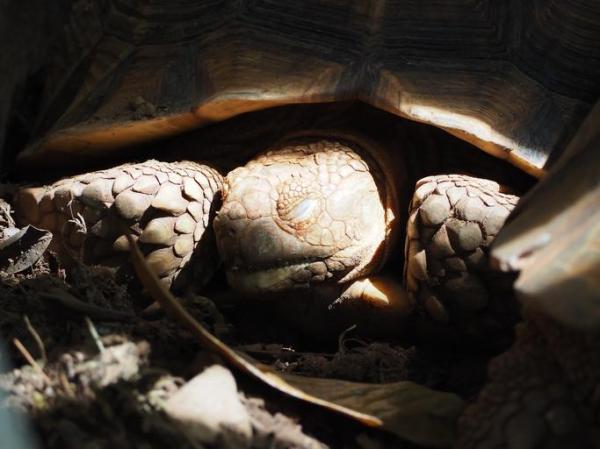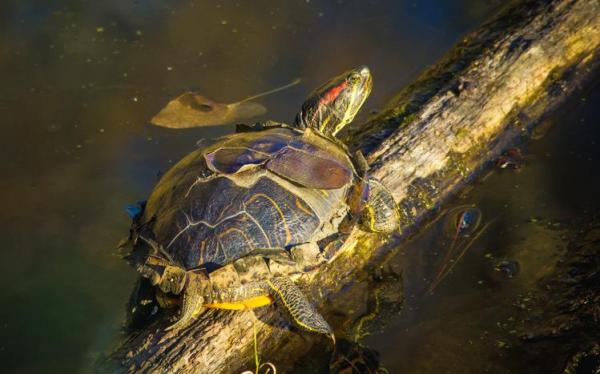
We should monitor a pet turtle's diet and provide it with a food tailored to the turtle's nutritional needs, which vary from species to species. Various health problems can be caused by inadequate nutrition, such as eye problems, lack of energy or lethargy, respiratory problems, and serious mineral and vitamin deficiencies, which can vary in severity.
Here in AnimalWised, we take a look at some of the reasons your tortoise may be refusing to eat, as well as some solutions.
Your turtle is susceptible to changes in their environment
First of all, you should know that turtles by nature often fast for a few days, and this is completely normal for them. However, if the fasting goes on for too long, it may be an indication that something is wrong with our turtle. Most of the reasons why turtles stop eating have to do with a change in their environment. Even small changes in their routine or diet can have this effect on turtles. So the first thing you should do is check to see if there have been any recent changes that could be affecting your turtle. Below is a list of the most common changes.
Changes in their environment
- Changes in their environment or routine: Turtles can stop eating if you change the feeding schedule or provide less light than usual. Remember that tortoises need adequate light to have a healthy appetite. Ideally, a turtle should receive 12 hours of light per day.
- Sudden changes in temperature or humidity: The turtle is a cold-blooded animal, so if the temperature is too cold, it will not eat. Check the temperature in your turtle's environment with a thermometer and make adjustments if necessary.
- Changes in the family: Contrary to what most people think, turtles are very sensitive to any small change in their environment. They may even notice when a new member enters the household, such as a child or pet.
You can learn more tips about how to properly care for a pet turtle by reading this article on pet turtle guide for beginners.

Your turtle is susceptible to changes in their diet.
Turtles are susceptible to changes in their diet, so for example, if you change the brand of pallets that you usually offer, they may initially reject it. You need to also consider that your turtle may not be eating simply because it does not like the food that you have been offering.Your turtle has preferences that you must learn. We give you some tips to increase your turtle's appetite.
- Provide live food occasionally: Live foods such as crickets, mealworms, waxworms, earthworms, snails, slugs, or small pink mice are more attractive to your turtle because they move and have a strong smell.
- Combine pallets with other kind of food: If your turtle responds to the live food but still refuses to eat pellets, you can crush the pellets and combine them with other food.
- Provide colorful food: Normally fruit should not be a staple food for your turtle, but you can use it to get your turtle to eat. Since turtles are naturally attracted to colorful foods, you can try giving your turtle strawberries, tomatoes, papaya, mango, watermelon, rose petals, or other colorful vegetables and fruits.
If you are interested in learning about your turtle's diet, do not miss this article on turtle's diet: what they can and can't eat.
Your turtle can be ill
As we have already said, the most common reasons why a turtle does not eat as usual are usually due to changes in its environment or diet. However, if the turtle refuses to eat or drink for a long period of time, it may be sick and need veterinary treatment. We will explain the most common symptoms of sick turtles that might prevent them from eating, so you can decide whether or not to take them to the vet:
- If your turtle has white, blotchy discoloration on its shell and refuses to eat, your turtle may be suffering from vitamin A deficiency. Vitamin A deficiency is also associated with respiratory infections in turtles.
- Other symptoms of respiratory infections include wheezing, difficulty breathing, sneezing, runny nose, puffy eyes and lack of energy.
- If your turtle stops eating and will not go to the bathroom, it may be constipated.
- If your turtle has eye problems and can not see, it will not eat. Check your turtle's eyes to make sure they are clear, free of debris and shiny.
In case our pet displays these symptoms, it is best to get it checked by a veterinarian as soon as possible. In addition to eye infections, respiratory diseases and parasites are some of the diseases that can cause a turtle to not eat. You can learn more about your turtle's health by reading this article on common diseases of turtles and tortoises.
Your turtle can be suffering from vitamin deficiency
If your turtle refuses to eat and you find that it is also unable to open its eyes, it is probably suffering from a common condition called hypovitaminosis, which causes it to be unable to open its eyes. Hypovitaminosis is a condition caused by a lack of a vitamin. You should see a veterinarian to determine if it is indeed hypovitaminosis or if the problem is caused by a fungal infection or a bacterial infection. If hypovitaminosis is treated with a change in diet and vitamin A-rich eye drops, improvement usually occurs relatively quickly.

Your turtle might be "hibernating"
Our turtle's lack of appetite could simply be a result of hibernation, which is associated with a long and deep sleep. Both land and water turtles are known to hibernate during the winter. However, they do not hibernate like bears or other mammals. Instead, turtles fall into a deep sleep known as brumation. Unlike other animals that hibernate, turtles remain partially active during brumation. This natural mechanism allows them to conserve their energy when food is scarce. Also, if your turtle finds the right environment and plenty of food, it may choose to hibernate.
Take your turtle to the veterinarian to determine if it may be trying to hibernate. The stress of hibernation is harmful to turtles. Only healthy turtles should hibernate.
If you want to learn more about this process, read our article about brumation and the differences between brumation and hibernation.

Your turtle has a calcium deficiency
When the shell of our turtle begins to lose hardness and color, it is important to act as soon as possible, otherwise this can lead to serious health problems. Softening of the shell is usually caused by weakened calcium absorption, as well as a diet deficient in this mineral.
Calcium is important for keeping the shell in good shape, but it is equally important that the turtle receives enough UVB light. In order to absorb calcium from food, a turtle's body needs UVB rays to produce vitamin D3. Therefore, in these cases, a calcium-rich diet must be provided in combination with adequate UVB exposure if the turtle cannot be exposed to direct sunlight for at least 8-10 hours per day.

If you want to read similar articles to Why Is My Turtle Not Eating? - Possible Causes and Solutions, we recommend you visit our Diet problems category.
- David Alderton. (2016). Tortoise food and diet - calcium, vitamin D3 and not eating . ExoticDirect. Available at: https://www.exoticdirect.co.uk/news/tortoise-diet-calcium-vitamin-d3-and-not-eating
- Jennifer Parker. (2018). Anorexia in tortoises . Veterinary Practice. Available at: https://veterinary-practice.com/article/anorexia-in-tortoises
- Anorexia in Tortoises . Net Vet. Available at: http://www.netvet.co.uk/tortoises/anorexia.htm